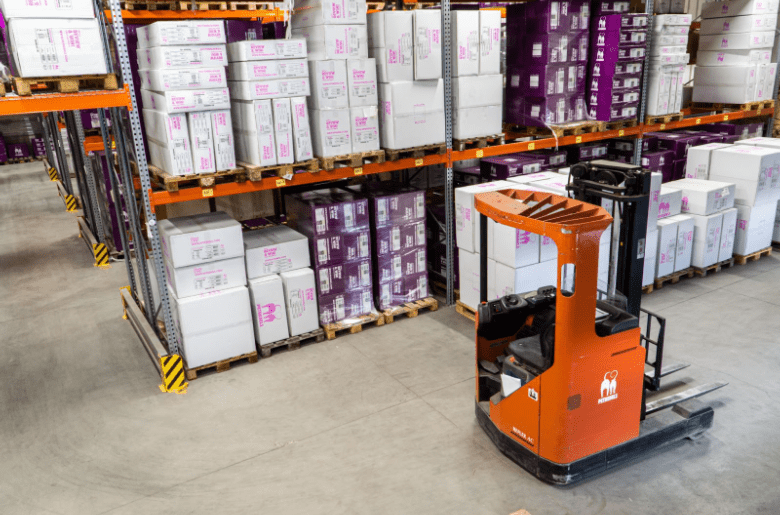Consignment Inventory: Definition, Advantages, and Disadvantages

Talk to any retailer and they will tell you without a doubt that there is a certain amount of risk that results from purchasing traditional inventory. This is because when retailers stock their products, they usually hope that they will sell enough to get a profit before their stock expires.
However, this will not always be the case. Merchandise can sometimes be overstocked or remain on the retailer’s shelves for weeks without the retailer making a single sale. This is when the inventory investment becomes a financial loss, and the retailer has to do something about it.
To ensure that they will not lose money, retailers have another option. They can incorporate a consigned inventory model, which operates differently from traditional inventory.
A consignment inventory works when a retailer purchases goods from the supplier, but rather than having them in their rightful possession, they rent them. This way, they have the goods and can sell them without the worry that they will go bad or be rendered ineffective by a competitor.
The main advantage of consigned inventory is that the retailer avoids dealing with excessive markdowns or even having to throw out consignment stock they didn’t sell from the retail store.
The downside of this method is that retailers can face obstacles in dealing with consignment inventory management, such as inventory discrepancies.
However, a consignment inventory is the answer to these obstacles, or at least reduces the stress that comes with them.
A complete guide to consignment inventory is presented below, so retailers can understand how consignment works, adapt to it, and avoid future problems in any consignment deal.
What is Consignment Inventory?
Consignment inventory refers to a business model/agreement or a supply chain approach whereby the consignor (manufacturer, supplier, or wholesaler) gives goods or inventory to the consignee (retailer/ retail store) for them to sell via different sales channels.
The consignee pays the consignor only when a customer purchases the goods and gets to keep the profits. In a consignment agreement, the consigner retains ownership of the goods until the consignee or retailer sells the goods to a client and makes the necessary payments to the consignor.
For instance, a retailer can strike an amicable consignment agreement with a medical device company and agree to incorporate a purchase inventory of their devices up front.
The manufacturer will conduct a stock transfer of the medical device’s inventory to the retailer and receive payment only from the sales of the devices. What the retailer will not sell (unsold products) will remain the manufacturer’s property.
When a consigned inventory is done right within the best-case scenario, it can offer a win-win situation to both the consignor and the consignee while the manufacturer/supplier still retains ownership.
Advantages of Consignment Inventory for Consignors
As mentioned earlier, consignors refer to manufacturers, wholesalers, or suppliers of goods. Since consignment inventory is similar to a rental agreement, the consignor can enjoy the advantages of a consignment model. These include:
Avoid Inventory Carrying Costs
Carrying costs refer to the amount of money/inventory costs a business will spend when holding a certain amount of inventory. In short, it refers to the cost of storing, owning, or keeping stock of the goods.

Since the consignors/suppliers transfer ownership and do not have to keep the consignment stock, they can incur a minimal cost or avoid the holding costs altogether. As a result, they will have more money to put toward other expenses associated with running the business.
Test Market Interest in Consignment Products
Consignors can use consignment inventory to gauge the interest in their products before they commit to creating and storing a vast quantity of them.
This is because when a retailer takes on consignment inventory, they usually hold a significant percentage of that particular consignment stock. The consignor can avail of this and present products on a smaller scale to the public during the consignment. This way, they can test how much demand there is for their product.
Streamlined Supply Chain
Cutting costs and eliminating inventory is the most crucial benefit of a consignment inventory model. But it also means streamlining the supply chain as well.
Consignment inventory can help suppliers, manufacturers, and wholesalers avoid the costs of carrying stock and separate storage units.
Being able to create a supply chain that doesn’t have excess costs and space makes it more efficient for the entire consignment process.
Build Relationships with Retailers
Since a retailer is willing to take on most of a product’s stock, the consignee is taking on quite a lot of risk. This means they are more likely to be loyal to their consignor.
When you consider that a retailer’s success can very well depend on their supplier, a consignor needs to keep their retailer satisfied to ensure that they have no intentions of changing consignors.
Increase Cash Flow
Consignors who implement a consignment inventory model can increase the cash flow within their business. This is because selling off some of the stock to customers, depending on the ownership models, can create space for another vendor-managed inventory, which will then help them earn more profit.
Advantages of Consignment Inventory for Consignees
Consignees refer to retailers or companies taking the responsibility of selling the consigned inventory on behalf of a manufacturer or supplier. It means that individuals, corporations, and businesses can be consignees.
These individuals and businesses can also enjoy advantages from consignment inventory:
A Wider Variety of Goods to Select From
When a retailer takes on consignment inventory, they usually request the product in bulk and put it in their store. Depending on the product, this will give them a wide variety of consigned goods to choose from and select based on their clientele, location, and market.
Cost Effective
It is essential to consider that a retailer pays for the number of consigned goods they sell from their store. In return, they do not have to carry the cost of consignment products that don’t sell and can avoid any possible markdowns or inventory losses.
Product Visibility
When retailers take on consignment inventory, they can benefit from product visibility. Since the retailer can incorporate selling inventory, they are more likely to promote and market the products to make more consignment sales.
Increase Cash Flow
Consignees can use this approach to increase sales and their income flow. This is because selling off some of the stock can create space in their store for another vendor-managed inventory, which will then help them earn more profit.
Stronger Relationships with Suppliers
Since a retailer is willing to take on most of a product’s stock, they are taking on quite a lot of financial risk.
The more they market and promote the consignment products, the more they establish a relationship with their suppliers since they share the same objective. This is important as it means they are more likely to be loyal to their supplier.
Disadvantages of Consignment Inventory
As with anything, there are disadvantages to consignment inventory as well. The most common ones include the following:
Low Visibility on Consignment Inventory
Low visibility can have adverse effects on retail stores, especially when it comes to new consignment products. It is usually hard to sell them.
The most common approach to overcome this problem is marketing the product to attract potential customers.
Although it may be a relatively easy experience for consignees, it requires lots of effort for them to sell.
Higher Carrying Costs to the Retailers
The retailers will be responsible for collecting the inventory from the warehouse. The higher it is, the higher their carrying costs and the more they have to pay to maintain it on the retailers’ shelves.
It also means that they will have to pay for additional costs like storage and upkeep of their stock in their warehouse. In short, it will cost them more and affect their margins after selling.
Cash Flow Issues
Retailers who use the inventory will not be able to collect payments until they sell the product. It means they can’t always use their money immediately when they expect more sales to happen.
It Is a Risky Approach
Being able to take on most of the product’s stock from the warehouse means that the consignor is taking on quite a lot of risk. This is because retailers can be unsuccessful in selling the products.
When this happens, the consignor/supplier may end up losing out on a lot more money than usual and the possibility of having to expand the inventory.
Additionally, some consignment products can be rendered ineffective after a certain period making it difficult for the retailer to sell those consignment products. This will also result in extra inventory costs and loss to the supplier.
Increased Challenges When It Comes To Managing Inventory
This supply chain strategy can also bring up challenges in stock management. This is because retailers need to track consigned items separately from those not consigned. It will help them monitor sales and restock consignments as needed from the supplier’s warehouse.
However, since these consigned items do not incorporate any upfront supply costs, it would be difficult for retailers to track their margins, thus making it difficult to make profits.
Consignment Inventory Management: Best Practices
Managing consignments is difficult; keeping track of stock and making appropriate payments that reflect recent sales require the utmost care and diligence. The following section has compiled a few best practices to help you manage your inventory effectively and gain more knowledge to make consignment inventory work for you.
Know Your Product
First and foremost, it is essential to know what your product is as a retailer. Different customers prefer many different types of products and goods. Knowing this will help you better understand what styles and items are currently in demand.
Knowing your product’s durability, quality, and marketability is also essential in a consignment model before making any sales.
Avoid Excess Supplying Of Consignment Products as a Consignor
As a consignor/supplier, it is vital to monitor and manage your inventory supply on a consignment basis. You must supply only when necessary and in the correct quantity.
It is preferable to have a comprehensive production plan to help you determine the necessary supply amount to achieve this. It will help avoid oversupplying from your store and save you from unnecessary financial burdens.
Use a Contract That Is Mutually Agreeable To Both Parties
Consignors and consignees must have contracts that are mutually agreed upon. It will help them avoid any possible miscommunication in the future that can lead to unexpected losses. The contract must incorporate at least the following:
- Accurately stated freight policy and shipping costs.
- A sustainable sale commission rate of the consignment inventory arrangement.
- A precisely indicated return policy (for goods not sold).
Contracts that do not reveal this information can cause unnecessary misunderstandings, which can be expensive to the parties involved.
Incorporate the Use of Inventory Management Software
Inventory management software is changing the way people do business daily. It has made it easier for businesses to boost sales and product margins by handling tracking, accounting, and forecasting.
An effective inventory management system will help you keep track of your consignments by noting the items and their current and projected sell-through rates.
Here are a few examples of currently available inventory management software:
- NetSuite: This inventory software offers various features like cost management, consigned stock tracking, barcoding, shipment tracking, and other helpful tools to handle consignment inventory effectively.
- Zoho Inventory: This is a user-friendly cloud-based software that operates on a subscription basis. It will provide you with everything you need in your consignment arrangement. It is one of the best inventory systems for small retailers and large distribution companies.
- Ecomdash: This cloud-based software provides users free access to several built-in features like product comparison, items by category, and order tracking at multiple locations. It is best for small and medium businesses that want to manage consignment inventory effectively.
- Cin7: This software offers a comprehensive set of tools for tracking and reporting. It also comes with automated reporting and enables users to communicate and share information quickly, conveniently, and efficiently.
- Fishbowl: This is another high-performance software for enterprise customers and growing brands. It has a wide range of customizable features that can be customized and tailored to meet an organization’s specific consignment arrangement.
Wrapping Up
A consignment inventory, unlike traditional methods, is a cost-effective way to maintain a profitable business at low risk. However, it can be challenging to manage consignments if you do not have the right tools and expertise. The above-mentioned best practices should help you streamline inventory management up to the end user.

